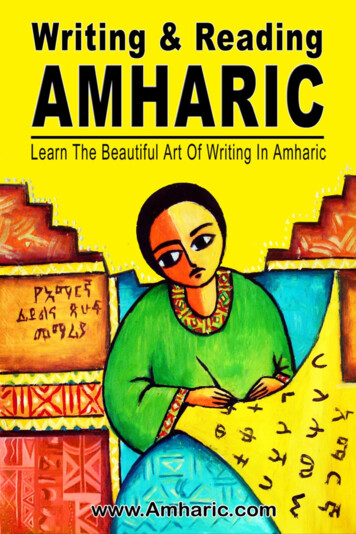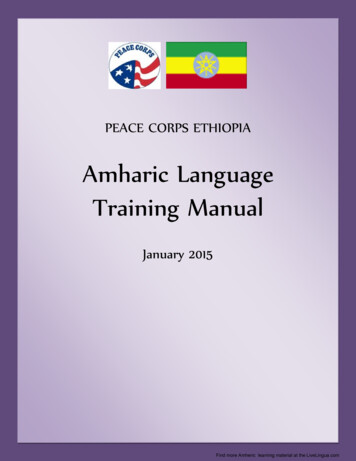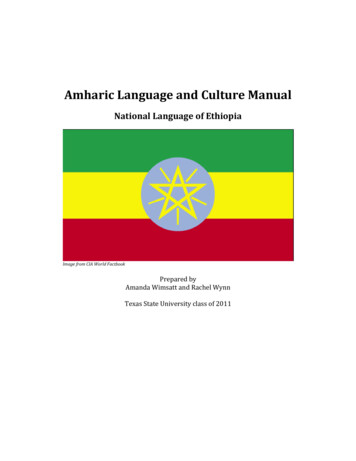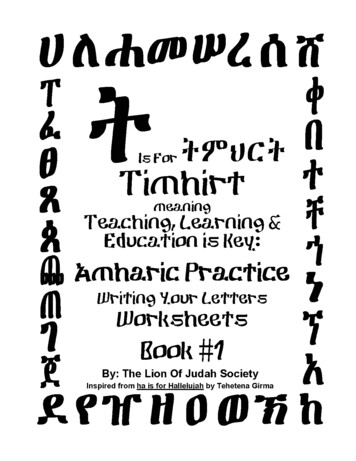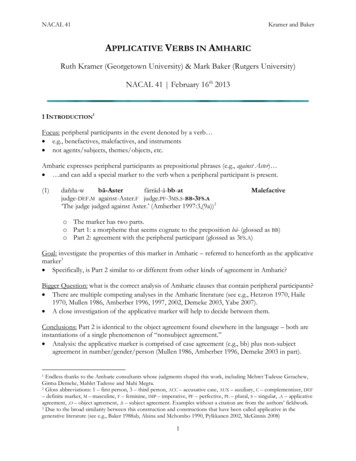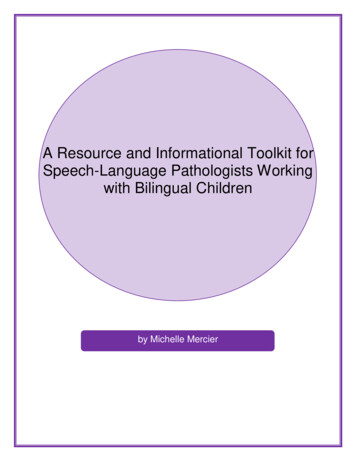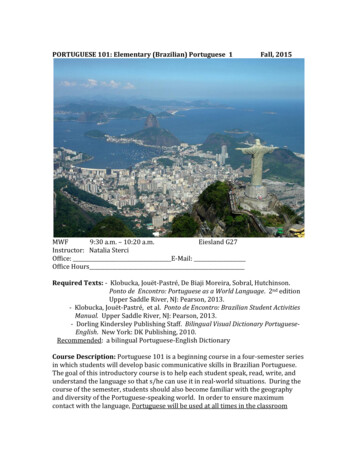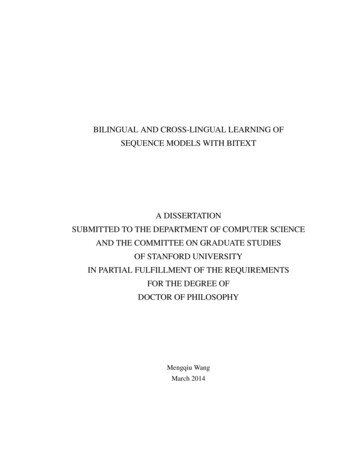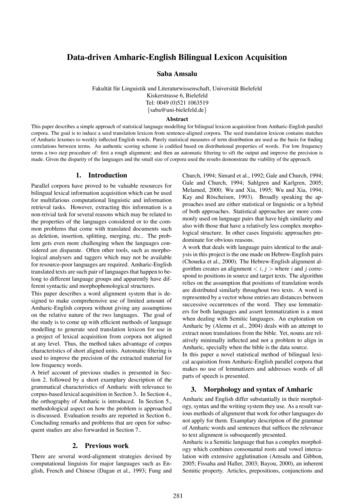
Transcription
Data-driven Amharic-English Bilingual Lexicon AcquisitionSaba AmsaluFakultät für Linguistik und Literaturwissenschaft, Universität BielefeldKiskerstrasse 6, BielefeldTel: 0049 (0)521 1063519{saba@uni-bielefeld.de}AbstractThis paper describes a simple approach of statistical language modelling for bilingual lexicon acquisition from Amharic-English parallelcorpora. The goal is to induce a seed translation lexicon from sentence-aligned corpora. The seed translation lexicon contains matchesof Amharic lexemes to weekly inflected English words. Purely statistical measures of term distribution are used as the basis for findingcorrelations between terms. An authentic scoring scheme is codified based on distributional properties of words. For low frequencyterms a two step procedure of: first a rough alignment; and then an automatic filtering to sift the output and improve the precision ismade. Given the disparity of the languages and the small size of corpora used the results demonstrate the viability of the approach.1. IntroductionParallel corpora have proved to be valuable resources forbilingual lexical information acquisition which can be usedfor multifarious computational linguistic and informationretrieval tasks. However, extracting this information is anon-trivial task for several reasons which may be related tothe properties of the languages considered or to the common problems that come with translated documents suchas deletion, insertion, splitting, merging, etc. The problem gets even more challenging when the languages considered are disparate. Often other tools, such as morphological analysers and taggers which may not be availablefor resource-poor languages are required. Amharic-Englishtranslated texts are such pair of languages that happen to belong to different language groups and apparently have different syntactic and morphophonological structures.This paper describes a word alignment system that is designed to make comprehensive use of limited amount ofAmharic-English corpora without giving any assumptionson the relative nature of the two languages. The goal ofthe study is to come up with efficient methods of languagemodelling to generate seed translation lexicon for use ina project of lexical acquisition from corpora not alignedat any level. Thus, the method takes advantage of corpuscharacteristics of short aligned units. Automatic filtering isused to improve the precision of the extracted material forlow frequency words.A brief account of previous studies is presented in Section 2. followed by a short examplary description of thegrammatical characteristics of Amharic with relevance tocorpus-based lexical acquisition in Section 3. In Section 4.,the orthography of Amharic is introduced. In Section 5.,methodological aspect on how the problem is approachedis discussed. Evaluation results are reported in Section 6.Concluding remarks and problems that are open for subsequent studies are also forwarded in Section 7.2. Previous workThere are several word-alignment strategies devised bycomputational linguists for major languages such as English, French and Chinese (Dagan et al., 1993; Fung andChurch, 1994; Simard et al., 1992; Gale and Church, 1994;Gale and Church, 1994; Sahlgren and Karlgren, 2005;Melamed, 2000; Wu and Xia, 1995; Wu and Xia, 1994;Kay and Röscheisen, 1993). Broadly speaking the approaches used are either statistical or linguistic or a hybridof both approaches. Statistical approaches are more commonly used on language pairs that have high similarity andalso with those that have a relatively less complex morphological structure. In other cases linguistic approaches predominate for obvious reasons.A work that deals with language pairs identical to the analysis in this project is the one made on Hebrew-English pairs(Choueka et al., 2000). The Hebrew-English alignment algorithm creates an alignment i, j where i and j correspond to positions in source and target texts. The algorithmrelies on the assumption that positions of translation wordsare distributed similarly throughout two texts. A word isrepresented by a vector whose entries are distances betweensuccessive occurrences of the word. They use lemmatizers for both languages and assert lemmatization is a mustwhen dealing with Semitic languages. An exploration onAmharic by (Alemu et al., 2004) deals with an attempt toextract noun translations from the bible. Yet, nouns are relatively minimally inflected and not a problem to align inAmharic, specially when the bible is the data source.In this paper a novel statistical method of bilingual lexical acquisition from Amharic-English parallel corpora thatmakes no use of lemmatizers and addresses words of allparts of speech is presented.3.Morphology and syntax of AmharicAmharic and English differ substantially in their morphology, syntax and the writing system they use. As a result various methods of alignment that work for other languages donot apply for them. Examplary description of the grammarof Amharic words and sentences that suffices the relevanceto text alignment is subsequently presented.Amharic is a Semitic language that has a complex morphology which combines consonantal roots and vowel intercalation with extensive agglutination (Amsalu and Gibbon,2005; Fissaha and Haller, 2003; Bayou, 2000), an inherentSemitic property. Articles, prepositions, conjunctions and281
personal pronouns are often inflectional patterns of otherparts of speech and can only seldom occur as disengagedmorphemes. Apparently, sentences in Amharic are oftenshort in terms of the number words they are consisted of.For the reader to assimilate the flavour of the problem, justpicking the first sentence in the bible in Amharic and English,accommodates this discord in syntax. In a two dimensionalCartesian plane of alignments between source and targettexts we do not expect a linear path, rather it would beskewed at the position of inversion of the verb and object.See the chart in Figure 2 for the portray of the mapping ofour example sentences.we obtain a ratio of 1:2 words.This is a common case as far as the two languages are concerned. The texts that are used in the experiment presentedin this paper have a ratio of 22179:36733, which is approximately 1 Amharic word to 1.7 English words.But if we try to consider morphemic substratum we observea different result. In Figure 1, a projection at nearly morpheme level is presented.Figure 2: Non-linear alignment.4.Figure 1: Morphemic alignment.Definiteness in Amharic is not necessarily explicitly represented. It is often left to be understood contextually. Whenit is explicit the definite article is realized as a suffix andrarely the indefinite article is expressed with a number coming before the noun such as ’and säw’, literally it means’one man’, parallel to the English ’a man’. The definite article ’the’ that occurs three times in the English sentencein Figure 1 is in all cases implicit in the Amharic translation. Hence, there are floating words in the English sidethat are not aligned. The object marker’ ’ in Amharic alsodoes not exist in English. This paper does not give a detailed account of Amharic morphology; better treatmentsare given by (Yimam, 1994; Yimam, 1999; Bender and Fulas, 1978; Berhane, 1992; Dawkins, 1960; Amare, 1997;Markos, 1991; Amsalu and Gibbon, 2005).Syntactically Amharic is an SOV language. It does not havefree order as in other Semitic languages. The generalisationgiven by (Choueka et al., 2000) about the free word orderfor Semitic languages does not hold for Amharic. Takingtheir own example,The boy ate the apple (English)the correct representation in Amharic is:The boy the apple ateThis forbids a linear alignment of Amharic words with theirEnglish equivalents which are revealed in SVO order. Thebroken line in Figure 1 shows a cross-over alignment thatAmharic orthographyAmharic uses a syllabary script called Fidel, withgraphemes denoting consonants with an inherent following vowel, which are consistently modified to indicate othervowels or, in some cases, the lack of a vowel. There are nodifferent representations of upper and lower cases, hencethere is no special marking of the beginning of a sentenceand first letter of names or acronyms. Words are separatedby white space. The streams of characters, however, arewritten left-to-right deviating from its relatives Hebrew andArabic.Differences in writing system reflects on attempts to aligncognates. Amharic and English do not share many wordssuch as, say, English and German do, but scientific words,technical words and names of places and people or objectsare often either inherited from English or both take themfrom some other language. Phonetically, cognates soundthe same. For example the word ’police’ is also ’p@li:s’ inAmharic phonologically decoded, but when written in Fidel. In effect, it does not have any relation whatsoeverit isto its English complementary.5.Parallelizing wordsStatistical methods of modelling relations of translationwords have a limitation in that they require a large amountof corpora to align a relatively smaller size of lexicon incomparison to the total number of words in the texts. Thesize of corpora needs to be even bigger when highly inflected languages are used, because all variants of a givenword are considered different which will have tremendouseffect in altering the frequencies of occurrences. The dearthof large amounts of corpora is, on this account, a bottleneck for many languages. On the other hand linguisticapproaches require computational linguistic tools which in282
the case of Amharic operational systems are not immanent.There are only prototype level systems for morphologicalanalysis (Bayu, 2002; Bayou, 2000; Amsalu and Gibbon,2005) and POS taggers (Getachew, 2001; Adafre, 2005).Therefore, in this paper a statistical method that tries tomake optimal use of bounded amount of corpora withoutcausing too much of degradation in the outputs is proposed.Attempts to align words with attenuated distributional similarity are also made. For that cause, a filtering system thatfilters outputs obtained from the first alignment is developed.The assumption in taking distributional properties of wordsas the measure for their equivalence emanates from the belief that equivalent terms are distributed similarly throughout the texts. Hence, the distribution of each term in thesource language is compared to the distribution of everyterm in the target language.The final aim is to parallelize Amharic lexemes to weaklyinflected English words. The alignment algorithm does notexclude function words from computation rather the scoring scheme which is discussed in Section 5.3. distills themby keeping their scores low. From the Amharic side a significant proportion of the words have a high probability ofbeing included in the lexicon, while in the English sidethere will be floating words which would in many cases befunction words. A demonstration on our examplary bitextsegment is presented in Figure 3Figure 3: Aligned Words.Gaps for non-aligned words and crossing alignments toovercome syntactic differences are extant. Details of thealignment heuristics are discussed in subsequent subsections.5.1.All operations with the exception of splitting and mergingare machine based. At the same time distribution values oftokens were extracted. Translation memory which is not themajor part of this work was also produced as a by-product.5.2. Term distribution measuresThe distribution of a term is simply a measure of how frequently and where in the document it occurs. Texts are often divided into smaller segments inorder to decrease theamount of search space and consequently have limited options. In the case of this paper the small segments are sentences. Three parameters are used to describe the distribution of each term:1. Global-frequency: Frequency of occurrence in the corpus;2. Local-frequency: Frequency of occurrence in a segment; and3. Placement: Position of occurrence in the corpus.5.3. Scoring SchemeThe scoring scheme formularized is an original novelscheme that gives categorical scores for each distinct pairof distributions and favours those that are distributed similarly. The scoring scheme also handles function words robustly.In set-theoretic terms, we have a set of distributions anda set of terms. Let Da be the set of distributions in theAmharic text and De be the set of distributions in the English text. And let Ta be the set of terms in Amharic textand Te be the set of terms in English text. Then if anAmharic Term T ermj Ta has a distribution Dj Daand an English term T ermk Te has a distribution Dk De , then the score of the translation candidates T ermj andT ermk is a measure of the degree of similarity between thedistributions Dj and Dk .Hence, we have an nxs and an mxs matrices; where n andm are the number of unique terms in Amharic and Englishrespectively and s is the number of segments in either ofthe texts. The values in the matrix are local frequencies.Therefore, each word is a weighted vector of its distribution; where the weight is its local frequency in the respective segment. If for example T ermj , is an Amharic termvector, with the values: T ermj (0, 2, 1, 0, 0) and suppose we have a term in the English document, T ermk (0, 1, 1, 0, 1). Then,Data preparationThe data sources used for testing the canonization and thesystems and subsystems developed thereof are the booksof Matthew and Mark in the bible. Preliminary processingsteps fundamentally consisted of:Score(j,k) 2·22 · Σ(T ermj T ermk )i 0.67 6Σ(T ermj T ermk )iwhere i denotes the ith entry of a vector, andT ermj T ermk (0, 2, 1, 0, 0) (0, 1, 1, 0, 1) text segmentation, ( 0,1,1,0,0), tokenization andT ermj T ermk (0, 2, 1, 0, 0) (0, 1, 1, 0, 1) splitting and merging. ( 0,3,2,0,1)283
If instead we have pairs of T ermj (0, 1, 1, 0, 0) andT ermk (0, 1, 1, 0, 1),T ermj T ermk (0, 1, 1, 0, 0),T ermj T ermk (0, 2, 2, 0, 1)Score(j,k) 2·22 · Σ(T ermj T ermk )i 0.8 5Σ(T ermj T ermk )iagain, for T ermj(0, 2, 1, 0, 1), (0, 2, 1, 0, 0) and T ermk T ermj T ermk (0, 2, 1, 0, 0),T ermj T ermk (0, 4, 2, 0, 1)Score(j,k) 2·32 · Σ(T ermj T ermk )i 0.86 7Σ(T ermj T ermk )iThe constant 2 in the numerator is algebraized to normalisethe scores to range between 0.0 (for disjoint vectors) and1.0 (for identical vectors), which otherwise would havebeen in the range of 0.0 to 0.5.5.4. ThresholdsObviously candidates with low score are bad candidates.But the question is, what values of score are low? To determine this cutting point different thresholds of score abovewhich candidates could be true translation were tested onthe corpus and the one that gives reasonably good translation pairs is selected. But again not all candidates withhigh score are true translations. In fact for a small size ofcorpus many of the candidates with a score of 1.0 are lowfrequency words. Hence, to control this a second thresholdfor frequencies is set.5.5. Filtering mechanismIn statistical methods of alignment, the words that can mostlikely be correctly aligned are high frequency words. Thisis because there are many instances of these words that enable them to survive from accidental collisions with falsetranslations. But for low frequency words, it is highly likelythat just by chance they could co-occur with words that arenot their equivalents. Specially when the test is made on asmall size of corpora, low frequency words are too manyand often coincide with several other low frequency words.One commonly used method of avoiding such coincidences is to amputate low frequency words from evaluation set. Other methods of filtering are looking intoknowledge sources such as the parts of speech of alignedtexts, machine readable dictionaries, cognate heuristics,etc. (Melamed, 1995). In this paper a simple operation ofannihilating those words that are aligned with equal scoreto different words is made.6. EvaluationThe statistical language model developed is evaluated ona dataset of 20,347 Amharic and 36,537 English words,which encompass 6867 and 2613 unique words in Amharicand English respectively. The first attempt to screen thecandidates with higher score and high frequency is presented in Table 1.For score 0.7 and Σ(T ermj T ermk )i 5, amongthe 38 errors, 30 of them are due to candidates withΣ(T ermj T ermk )i between 6 9. Hence, the thresholdfor frequency is set to 9. Again, keeping the frequencythreshold fixed the score is lowered until 0.55. For scoresbelow 0.55 the accuracies went below 80%.To exploit the low frequency words, a two step analysis isassembled. First a higher threshold is set for them, seconda filtering algorithm is designed to screen those words withmultiple equal score translations. For Σ(T ermj T ermk )ibetween 6 9 with score 0.8, 64.71% has been obtained before filtering and 82.35% after filtering.The filter for one and two frequency words, selects allwords that match with a score of 1.0 with one and only oneword. After filtering, accuracies of 51.61%and 43.55% fortwo and one frequency words (i.e. Σ(T ermj T ermk )iequal to 4 and 2) respectively is achieved.6.1. Analysis of the resultsThe score threshold level for which a good percentage wasfound before filtering is 0.55. This means the distributionsof translation candidates need only overlap in almost 50%of the case. This is an advantage for inflectional variants ofAmharic that fail to align quite well with their counterpart.Surprisingly enough our method works well even with lowfrequency words. The translation pairs need to have a frequency sum 9. This means that each word on averageneeds to appear in the text only 4.5 times. This is withoutfiltering. With filtering words of frequency 3 also give goodresults. Most other existing systems use a higher frequencythreshold (Sahlgren and Karlgren, 2005).The weakness of this system lies on the inability to handle multiword compounds. Verbal compounds as wellas many nominal compounds are written as two separatewords (Amsalu and Gibbon, 2005). Split compound alignments are reckoned as wrong matches. Excluding themfrom the result set, the accuracy of our experimentation increases to 87.76%.Lets give an examplary explanation of the case, for moreclarity of the facts. The analogue for the word ’disciple’ inAmharic is ’däk̆ä mäzmur’. The constituent words alwayscome together. Nevertheless, a statistical alignment systemknows them to be two separate words. Yet, since they always appear as a unit, each one of them are likely to matchwith every word in the English text with equal score. Toexemplify it, suppose we have,Score disciple , däk̆ä 0.7 andScore disciple , mäzmur 0.7It is easy to excavate them from the result set by simplysetting a conditional rule that if a word is aligned with avalue which is its best score with two terms, then accouplethe two terms as strings of a compound and align the singleword to them, i.e.,284
ScoreΣ(T ermj T ermk )iCorrectCompoundsWrongTotal% Correct 0.7 5123163817769.49% 0.6 913482016282.72% 0.55 917292420583.90%Table 1: Candidates of high score and high frequency.Score disciple , däk̆ä mäzmur 0.7Corpus data can be used to find which string comes first.But there are two problems that block us from using theirscore as a measure of their association. First, compoundscould be inflected. Inflection may alter either or both ofthe elements. If the compound takes a prefix, the first element will be affected. If the compound takes a suffix thesecond element will be changed. This will mess up thescores. The second problem arises for the reason that inmost cases, the second part of the compound can exist unbound. And when it occurs independently it has alltogetheranother meaning. In our example multiword compound, thesecond part ’mäzmur’ means ’song’.The best plausible solution would possibly be to mark compounds as one word right from the beginning. That way,even if they are inflected they will only be affected likeany other word would. In an attempt to excerpt compoundsfrom the corpus, bigram distributions of words were generated. Perhaps because the document size was small therewere many non-compound bigrams that occurred as frequently as the compounds.7.Conclusions and future workThe work described in this paper demonstrates that alignment of disparate languages using statistical methods is viable. It is also possible to gain good translation matcheseven for low frequency words with the assistance of simplefiltering measures.Research on the use of other approaches that depend onsimple linguistic features of texts, such as syntacticallyfixed realizations of terms and expressions and alignmentsof above word level strings in context are on their way (Amsalu and Gibbon, 2006). Empirical methods for generating more lexical items from the original corpus, given theknown translations in the corpus and maximum likelihoodestimates that consider every word in the documents arealso being investigated. Reusing the seed lexicon to alignbigger chunks of text is worth attention. The use of bigramand trigram alignments which for the corpus used here didnot produce good results may be tested on a bigger sizecorpora.8.ReferencesSisay Fissaha Adafre. 2005. Part of speech tagging foramharic using conditional random fields. In ProceedingsACL-2005 Workshop on Computational Approaches toSemitic Languages, pages 47–54.Atelach Alemu, Lars Asker, and Gunnar Eriksson. 2004.Building an amharic lexicon from parallel texts. In Proceedings of: First Steps for Language Documentation ofMinority Languages: Computational Linguistic Tools forMorphology, Lexicon and Corpus Compilation, a workshop at LREC, Lisbon.Getahun Amare. 1997. Zämänawi yamarNa Säwasäwbäqälal aqäraräb. Commercial Printing Press, AddisAbaba.Saba Amsalu and Dafydd Gibbon. 2005. Finite state morphology of amharic. In International Conference onRecent Advances n Natural language processing 2005,pages 47–51, Borovets.Saba Amsalu and Dafydd Gibbon. 2006. Methods of bilingual lexicon extraction from amharic-english parallelcorpora. In World Congress of African Linguistics, Addis Ababa.Abiyot Bayou. 2000. Design and development of wordparser for amharic language. Master’s thesis, Schoolof Graduate Studies of Addis Ababa University, AddisAbaba.Tesfaye Bayu. 2002. Automatic morphological analyserfor amharic: An experiment employing unsuppervisedlearning and autosegmental analysis approaches. Master’s thesis, School of Graduate Studies of Addis AbabaUniversity, Addis Ababa.Lionel M. Bender and Hailu Fulas. 1978. Amharic VerbMorphology. African Studies Center, Michigan StateUniversity.Girmaye Berhane. 1992. Word formation in amharic.Journal of Ethiopian Languages and Literature, pages50–74.Yaacov Choueka, Ehud S. Conley, and Ido Dagan. 2000.A comprehensive bilingual word alignment system. application to disparate languages: Hebrew and english. InParallel text Processing: Alignment and use of Translation Corpora. Kluwer Academic Publishers.Ido Dagan, Kenneth W. Church, and William A. Gale.1993. Robust bilingual word alignment for machineaided translation. In Proceedings of the Workshop onVery large Corpora: Academic and Industrial Perspectives, pages 1–8, Columbus, Ohio.C. H. Dawkins. 1960. The Fundamentals of Amharic. Sudan Interior Mission, Addis Ababa.Sisay Fissaha and Johann Haller. 2003. Amharic verb lexicon in the context of machine translation. In Traitement285
Automatique des Langues Naturelles, TALN2003, pages183–192.Pascale Fung and Kenneth W. Church. 1994. Kvec: Anew approach for aligning parallel texts. In COL–ING9J, pages 1096–1102, Kyoto.William A. Gale and Kenneth W. Church. 1994. A program for aligning sentences in bilingual corpora. Computational Linguistics, 19(1):75–102.Mesfin Getachew. 2001. Automatic part of speech taggingfor amharic language: An experiment using stochastichmm. Master’s thesis, School of Graduate Studies ofAddis Ababa University, Addis Ababa.Martin Kay and Martin Röscheisen. 1993. Text–translation alignment. Computation Linguistics, 19:121–142.Habte Mariam Markos. 1991. Towards the identification ofthe morphemic components of the conjugational formsof amharic. In Proceedings of the Eleventh InternationalConference of Ethiopian Studie, Addis Ababa.I. Dan Melamed. 1995. Automatic evaluation and uniformfilter cascades for inducing n–best translation lexicons.In Proceedings of the Third Workshop on Very LargeCorpora, Boston.I. Dan Melamed. 2000. Pattern recognition for mappingbitext correspondance. In Jean Vèronis, editor, ParallelText Processing: Alignment and Use of Translation Corpora, chapter 2, pages 25–48. Kluwer Academic Publishers.Magnus Sahlgren and Jussi Karlgren. 2005. Automaticbilingual lexicon acquisition using random indexing ofparallel corpora. Natural Language Engineering, 11(3).Michel Simard, George F. Foster, and Pierre Isabelle. 1992.Using cognates to align sentences in bilingual corpora.In Proceedings of the Fourth International Conferenceon Theoretical and Methodological Issues in MachineTranslation (TMI 92), pages 67–81, Montreal.Dekai Wu and Xuanyin Xia. 1994. Large-scale automaticextraction of an english-chinese translation lexicon. InProceedings of the First Conference of the Associationfor Machine Translation in the Americas, pages 206–213, Columbia,Maryland.Dekai Wu and Xuanyin Xia. 1995. Large-scale automaticextraction of an english-chinese translation lexicon. Machine Translation, 9(3-4):285–313.Baye Yimam. 1994. YamarNa Säwasäw. E.M.P.D.A, Addis Ababa.Baye Yimam. 1999. Root reductions and extensions inamharic. Ethiopian Journal of Languages and Literature, pages 56–88.286
Amharic by (Alemu et al., 2004) deals with an attempt to extract noun translations from the bible. Yet, nouns are rel-atively minimally inflected and not a problem to align in Amharic, specially when the bible is the data source. In this paper a novel statistical method of bilingual lexi-cal acquisition from Amharic-English parallel corpora that
